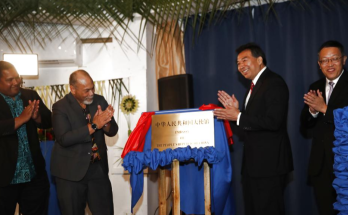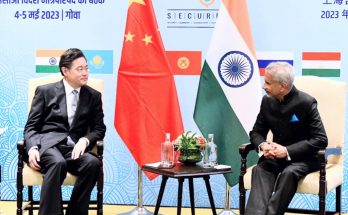 East Asia, the region from the Arabian Sea to the Sea of Japan, has been in the forefront of economic growth and strategic competition in this decade. The region continues to score well on economic parameters, but rising tensions on China’s periphery from Vietnam to the Philippines have caused widespread anxiety.
East Asia, the region from the Arabian Sea to the Sea of Japan, has been in the forefront of economic growth and strategic competition in this decade. The region continues to score well on economic parameters, but rising tensions on China’s periphery from Vietnam to the Philippines have caused widespread anxiety.
A Region on Boil?
Recently Chinese fighter jets flew within 50 metres of Japanese military planes engaged in surveillance of the disputed Senkaku/Diaoyu Islands, claimed by both countries, in East China Sea. The world witnessed stunning images of a Chinese ship subjecting a Vietnamese vessel to harsh water cannon treatment as an ultra-modern Chinese rig began oil exploration in South China Sea, in an area claimed by Vietnam to be in its exclusive economic zone.
Robert Kaplan wrote recently that East Asia “alienates” intellectuals. The fact, however, is that strategic scholars are intensely drawn to East Asia, keen to decipher implications of a complex strategic dance imbued with geopolitical overtones.
Strategic Trends
Several trends in the region are evident. All that talk about 21st century being “Asian century” has lost its shine as aggressiveness begets insecurity and nations get distracted from their agenda of development. Doubts about China’s rise being peaceful are on the rise. The US policy response of “pivot/rebalancing” has partially assured allies and partners, but uncertainty persists: can or will US really do enough to curb China’s growing assertiveness?
The story gets complicated further as the complexities of China-Japan relations are factored in. Japan, like the US, contributed immensely to the growth of Chinese economy, but paradoxically Japan’s relations with China are deeply tense today. Strains marking the great power relationships have taken a toll on ASEAN. Behind the cover of fragile unity lies the ugly reality of its divisions: Laos, Cambodia and Malaysia are known for their pro-China inclinations; Vietnam and Philippines are publicly engaged in territorial/maritime disputes with China; Myanmar is a sui generis case; and Indonesia, adopting a neutral stance, remains keen to play the mediator. Consequently, the much-trumpeted “centrality” of ASEAN stands diminished.
India’s Options
T hese interlinked developments have put a spotlight on what the Modi government might do to protect India’s interests in the region. It has inherited the Look East policy, supported by an overarching national consensus for the past two decades. The achievements of the policy are many, but it is not without its share of failings. To consolidate the gains and remedy the downside is the obvious way to go. South Block has revealed its plan to craft an Enhanced Look East Policy soon. To achieve this goal, our mandarins, under the new political leadership, will need to address critical issues pertaining to changing power equations, at least at four levels.
hese interlinked developments have put a spotlight on what the Modi government might do to protect India’s interests in the region. It has inherited the Look East policy, supported by an overarching national consensus for the past two decades. The achievements of the policy are many, but it is not without its share of failings. To consolidate the gains and remedy the downside is the obvious way to go. South Block has revealed its plan to craft an Enhanced Look East Policy soon. To achieve this goal, our mandarins, under the new political leadership, will need to address critical issues pertaining to changing power equations, at least at four levels.
Enhanced Look East Policy
Firstly, there is no escaping from some serious work to remove misgivings pertaining to the India-US relations and enhance bilateral cooperation, especially in East Asia where convergence trumps divergence. Secondly, for India the choice should not be between China and Japan. Both are needed as partners for accelerating India’s economic growth, a key goal of the new government. Just as the US and Japan made China stronger economically, Japan and China can contribute to India’s development. However, on the larger political issues, India will surely need to develop an equitable and effective balance of power that encourages nations to resolve their disputes peacefully. New Delhi should find tangible ways to work both with Beijing and Tokyo.
Thirdly, there is considerable scope for India to deepen its four strategic partnerships in the region i.e. Vietnam, Indonesia, Australia and South Korea. A comprehensive endeavour to cover all facets, particularly maritime security, defence cooperation and strategic understanding, is essential. This should stem from an accurate reading of the strategic situation: while the US favours a unipolar world with a multi-polar Asia and China favours a unipolar Asia in a multi-polar world, India’s welfare lies in a multi-polar Asia within a multi-polar world.
Fourthly, on the region’s economic integration, New Delhi needs to introspect deeply. It may conclude that the two parallel paths followed so far – Regional Comprehensive Economic Partnership and Trans-Pacific Partnership – contribute to fissures, not harmony. Our economic experts should explore possible merger of the two parallel processes.
At a recent conference of scholars in Kuala Lumpur, deliberations were marked by sharp polemics between Chinese and Japanese representatives. At one point the chair got so anxious that it asked those in the 400-strong audience to raise hands who thought that tensions in region might lead to a shooting war. Only a few hands went up. That was reassuring, but this indicates that accidents can happen, triggering uncontrollable consequences. Hence the time for innovative diplomacy is now.
( Rajiv Bhatia is Director General of the Indian Council of World Affairs, India’s premier foreign policy think tank. In his decades-long diplomatic career, he has served as India’s ambassador to many countries, including Myanmar and South Africa. The article has been written exclusively for India Writes Network, www.indiawrites.org, and reflects his personal views)
Rajiv Bhatia is Director General of the Indian Council of World Affairs, India’s premier foreign policy think tank. In his decades-long diplomatic career, he has served as India’s ambassador to many countries, including Myanmar and South Africa. The article has been written exclusively for India Writes Network, www.indiawrites.org, and reflects his personal views)
Author Profile
Latest entries
 DiplomacyJuly 11, 2014The BRICS journey: Scoring high in Fortaleza
DiplomacyJuly 11, 2014The BRICS journey: Scoring high in Fortaleza China ConnectJune 9, 2014India’s options: Peace and Conflict in East Asia
China ConnectJune 9, 2014India’s options: Peace and Conflict in East Asia India and the WorldOctober 15, 2013Indonesia and India: ‘Companion Souls’ as Strategic Partners
India and the WorldOctober 15, 2013Indonesia and India: ‘Companion Souls’ as Strategic Partners China ConnectSeptember 5, 2013It’s time to alter perception of India and China as rivals
China ConnectSeptember 5, 2013It’s time to alter perception of India and China as rivals






